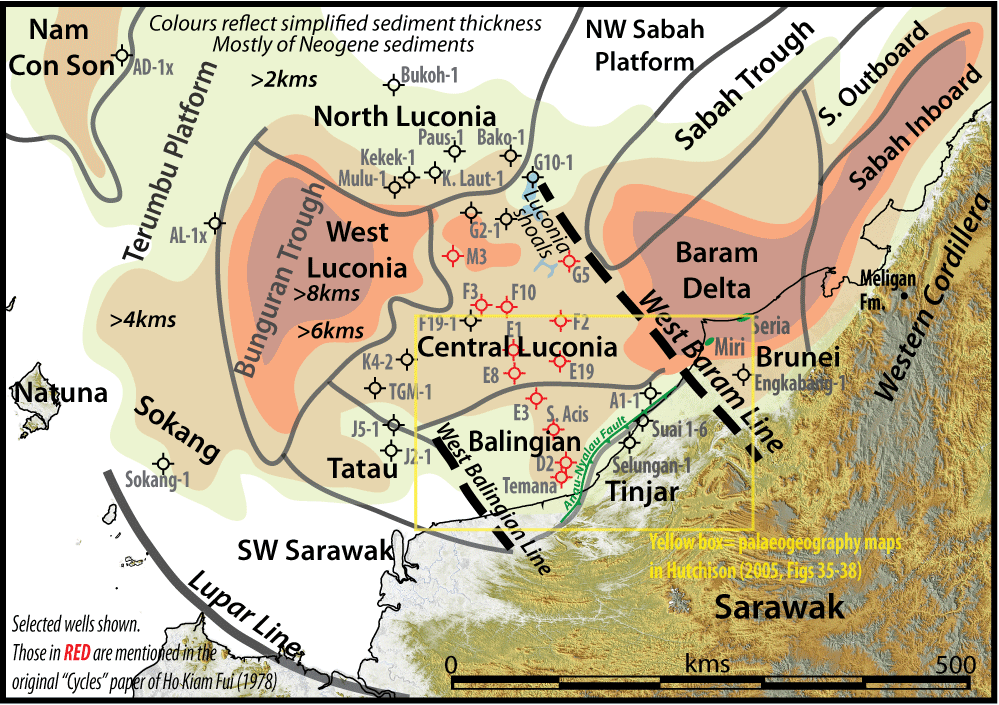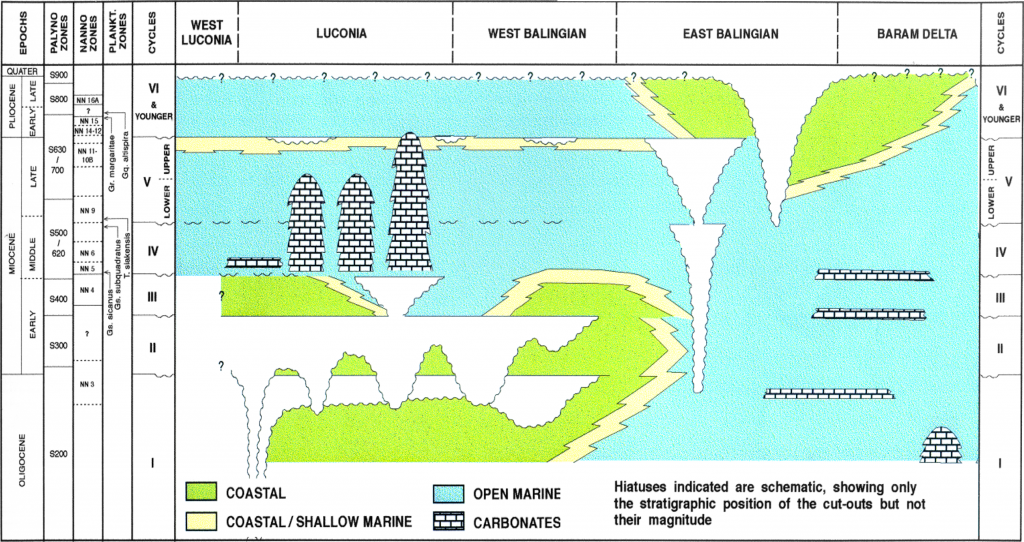I have suggested that a new, dynamic stratigraphy for SE Asia leads to new plays, a statement that needs validation. There are cases, such as sorting out the Kudat Formation / Stage III – Temburong Formation confusion in NW Sabah, re-defines a section previously considered economic basement to being a unit of oil source rock and reservoir (covered in papers in press, and a post when they are published). In Java the mid Oligocene uplift (Lunt, 2019) created structures on which new reefs grew (over bathyal clays), changing the old concept that reefs only formed over basement highs. This meant there were sub-limestone traps and plays in some structural trends.

Here I want to give a simpler example based on an analog in west Borneo. We know from the work of Ismail Mat-Zin and others (e.g. Hutchison, 2005) that the onshore Sarawak area began to be uplifted in the mid Late Miocene, roughly 8 Ma, within Cycle V. This substantial uplift, creating the Tinjar Province, was delimited by the Anau-Nyalau Fault running close to the modern Sarawak coastline. Within Upper Cycle V a new prograde of siliciclastics began (see cross-section below), and I suspect this was the influx of eutrophic conditions that killed off a lot of Luconia pinnacle reefs. This new sequence terminated with a very distinct sand unit, which is an important gas reservoir in the E11-F13 field (above the reefal gas in E11, not shown on map above but just east of the E8 location in south Central Luconia). The sand is widespread, including the supposedly “sand-poor” Rajang Delta filling the trough under the West Luconia Province, but across Luconia and Balingian it is rarely found in closure. A tale for another post; it is a distinct and thick sand even in a bathyal setting, in spite of being at the top of a prograding clinoform and interpreted on shape as “delta top” – we are still unsure of the sedimentary processes in such a setting. Model-driven ideas failed for this rapid dump of siliciclastics from a newly uplifted high.


So bearing this in mind, what happens in west Sabah with the onset of the Sabah Orogeny in later Early and base Middle Miocene times? We know deep marine Stage III was uplifted over a wide area until the pause that was the Deep Regional Unconformity (DRU). At this DRU subsidence the sedimentary systems retreated, and the sandy Stage IV-A sediments were then deposited over eroded Stage III (Levell, 1987 and others). This uplift, erosion and then subsidence is analogous to the upper Cycle V uplift, then Cycle VI transgression in Sarawak.
This suggests that in later Stage III times somewhere around west Sabah, as the first uplift was happening, there was erosion and a sequence of sedimentation must be present in a downslope setting that could be very much like the Upper Cycle V in Sarawak. There could be a range of sands from prograding, coarsening-up clastic bodies like in the E11-F13 area, as well as more distant turbidites. Clearly a lot of these basal Middle Miocene sediments will be buried beyond the reach of drilling, and below reservoir floor, by the Late Miocene fill in west Sabah and the Baram Delta. But not everywhere. There are overthrust units of this age in outboard Sabah that have just been tagged by two wells I know of (with oil shows – in one well written off as “Crocker Formation” by the misguided operator, in spite of an early Middle Miocene age). In NW Sabah and offshore Palawan I have never examined this section on seismic, but it has much less overburden. It is a viable play (there cannot be erosion without re-deposition) in an area where presence of reservoir is perhaps the main exploration risk. It simply does not figure on any play or exploration summary I have ever seen for Sabah. Unlike the end Cycle V sand in Sarawak, there is much more compression in west Sabah and a good chance such clastics are in closure somewhere.
References
Hutchison, C.S., 2005. Geology of North-West Borneo: Sarawak, Brunei, and Sabah. Elsevier Science.
Ismail, Che Mat-Zin. 1996. Tertiary tectonics and sedimentation history of the Sarawak basin, east Malaysia. Durham. PhD thesis. Available online
Ismail, Che Mat-Zin., 1997, Tectonics evolution and sedimentation history of the Sarawak Basin. Geological Society Malaysia Bulletin 41, 41-52.
Ismail, Che Mat-Zin, and R.E. Swarbrick. 1997. The tectonic evolution and associated sedimentation history of Sarawak Basin, eastern Malaysia: a guide for future hydrocarbon exploration. In Petroleum Geology of Southeast Asia, eds. A.J. Fraser, S.J. Matthews, and R.W. Murphy, 237-245. Geology Society Special Publications No. 126.
Levell, B. K., 1987, The nature and significance of regional unconformities in the hydrocarbon-bearing Neogene sequence offshore West Sabah. Geological Society Malaysia Bulletin 21, 55-90.
Lunt, P., 2019, The origin of the East Java Sea basins deduced from sequence stratigraphy. Marine and Petroleum Geology 105, 17-31.
Be First to Comment